|
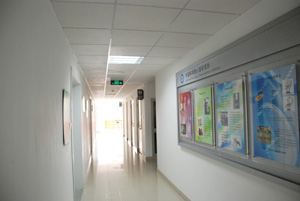 |
|
The Dreamworks of psychology, presented by Institution of Psychology, CAS, exhibit a series of classical psychological experiments and phenomenon. Through an exciting range of objects, artworks, audiovisuals and an interactive it sets out the essential techniques that most psychologists use in their everyday practice.
The exhibition covers different study fields in psychology, including developmental psychology, cognitive psychology, social psychology, industrial psychology, educational psychology, psychological testing, and personality psychology. In this park, children and adolescents can learn basic psychological knowledge through participating in games and interactive experiments.
|
|
Live monitoring system
This system shows what researchers are doing in the laboratories without disturbing them. Through the monitoring camera, visitor can see how researchers doing psychological experiments, how people and animal reacting to variety stimuli. |
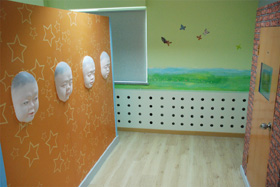  |
In the eyes of baby
Vision of human develops through childhood, and the development completes around 7 years old. This project virtualizes the sight of baby of different developmental stages. You could visualize the vision of old baby. The visual system is the most complex sensory system in the human body. However, it is the least mature system at birth. Newborns have poor acuity, their ability to change focus is limited, and they are very nearsighted. In this area, you can see how your face may look to an infant at different age, from one month to one year old in the computer-manipulated picture. |
| |
Crossing frozen river
This multi-media system is a fun way to assess children’s cognitive ability, memory, problem-solving ability, collaborative and communication skills, and shows some basic psychological mechanisms that can be easily applied in daily life.
In cognitive psychology and neuroscience, spatial memory is the part of memory responsible for recording information about one's environment and its spatial orientation. For example, a person's spatial memory is required in order to navigate around a familiar city, just as a rat's spatial memory is needed to learn the location of food at the end of a maze. It is often argued that a person's, or an animal's, spatial memories are summarised in a cognitive map.
This program also reveals reinforcement principles of behaviorism into practice. This principle suggests that, certain behavior will practice more often if rewarded, and exhibit less if punished.
|
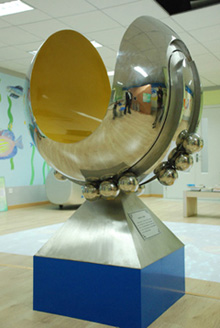 |
Tower of Hanoi
Tower of Hanoi is a classical math puzzle that was invented by the French mathematician Edouard Lucas, in 1883. The objective of the puzzle is to move the entire stack to another rod, obeying the following rules: 1, Only one disk may be moved at a time. 2, Each move consists of taking the upper disk from one of the pegs and sliding it onto another rod, on top of the other disks that may already be present on that rod. 3, No disk may be placed on top of a smaller disk.
The Tower of Hanoi is considered a classic example of the kind of task cognitive psychologists have their participants perform to illustrate problem-solving strategies. With the increase of the height of the tower, the difficulty increases. With a logic thinking, the participant could find a way to solve the question.
|
The window of the mind
A person's eyes reveal much about how they are feeling, or what they are thinking. You can tell a person's emotions simply by looking at their eyes. In grief, the eyes look down. In fear they flit and move searching for danger. In anger they fix and pierce the object of anger. Blink rate can reveal how nervous or at ease a person may be.
Tense eyes sometimes cause and always escalate mental moods and feelings. An implication of this experiment suggests that we can change our emotion by simply change our eyes. By becoming aware of the way your eyes work to affect your emotions, enables you to concentrate on your emotions and control them through your eyes. You can mentally command your eyes to relax, and blink you eyes to wash off your anger, fear, and other unwanted feelings.
|
 |
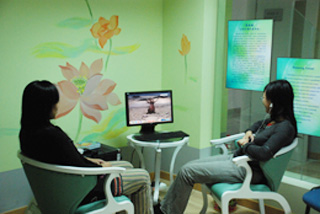 |
Relaxing forest
Biofeedback is a form of alternative medicine that involves measuring a subject's quantifiable bodily functions such as blood pressure, heart rate, skin temperature, sweat gland activity, and muscle tension, conveying the information to the patient in real-time. This raises the patient's awareness and conscious control of their unconscious physiological activities.
By providing the user access to physiological information about which he or she is generally unaware, biofeedback allows users to gain control of physical processes previously considered an automatic response of the autonomous nervous system.
|
 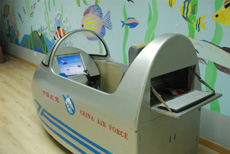 |
Knowing your mind: Psychological Tests
Computer-based tests are widely used in standardized psychological research and daily use.
The project contains several psychological tests which assess basic cognitive ability, advanced cognitive ability and personality. Basic cognitive ability test contains four separate programs testing the working memory storage, reaction acuity/speed, and attention.
Advanced cognitive abilities include logic thinking, learning, imagination and other abilities that require in-depth mental effort. These abilities, especially logic thinking, are often used as an index for human intelligence.
Personality can be defined as the distinctive and characteristic patterns of thought, emotion, and behavior that make up an individual’s personal style of interacting with the physical and social environment. In this program, you can assess your personality traits to Eysenck Personality Questionnaire (EPQ), one of the most widely used personality tests. According to Eysenck, there are three major personality factors: introversion-extraversion and emotional instability-stability, Psychoticism-Socialisation, under which there are many traits.
|
Can you be a pilot?
Pilot cognition and mental health test system is a virtual reality selecting and training program for potential pilots. This system assesses various cognitive abilities of participants. In this simple edition, participants practice virtual flying tasks, including basic cognitive skills, spatial relationships, and balance ability. Like play computer games, the trainee sets in a cockpit and controls the virtual plane through remote.
|
|
Amazing Faces
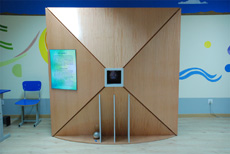
This project shows the differences between sensation and perception. Sensation is the pickup of information by our sensory receptors, for example the eyes, ears, skin, nostrils, and tongue. In vision, sensation occurs as rays of light are collected by the two eyes and focused on the retina. In hearing, sensation occurs as waves of pulsating air are collected by the outer ear and transmitted through the bones of the middle ear to the cochlear nerve. Perception is the interpretation of what is sensed, in another world, perception is how we organize information and make sense of it. Experiences and learning are some of the major sources of organization rules. From an aesthetic view, people used different cues from the relative position of organs, outline of the face, and background to judge the beauty.
| |
